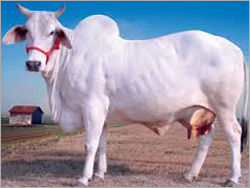Tharparkar
Tharparkar (named after the Thar Desert in Rajasthan) is a dual purpose and disease resistant cattle breed. The breed is also known as “White Sindhi”, “Grey Sindhi” and “Thari” as per the place of its actual origin (Sind, Pakistan). The breeding tract of the breed includes Kutchchh district of Gujarat and Barmer, Jaisalmer and Jodhpur districts of Rajasthan. The breed is medium sized compact with white and light grey coloured coat. Face and extremities are darker than rest of the body. In bulls neck, hump, and fore and hind quarters are also dark. The colour gets darker during winter. The animals can thrive well on small bushy vegetation (Sewan grass) during drought and fodder scarcity condition and produce reasonabe amount of milk with an average yield of 1749 kilo grams per lactation (ranging from 913 to 2147 Kg per lactation). Good animals with high nutrition have produced even higher than 3000 litre per lactation in farm condition. The males are also good for drought purpose. Due to better heat tolerance and disease resistance, this breed was used for producing “Karan Fries” breed - a synthetic crossbred cattle breed at National Dairy Research institute (NDRI)
For further details please see the following link
http://14.139.252.116/agris/breed.aspx
Animal Breeding Group, NDDB

Comments
Post a Comment